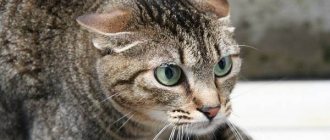Learning about the world from fairy tales and cartoons, we have learned that cats and dogs are at enmity, the wolf and the fox are friends, the mouse knows how to appear at the right moment, and “fools” are always lucky. Of course, fairy tales have morals, meaning, and some experience, but some of the clichés in them are wrong. The feud between cats and dogs is one of the made-up facts. Note that in almost all fairy tales, cats are very cunning and even two-faced, while dogs are simple-minded and naive. Let's get to the bottom of why cats and dogs often don't get along and what's stopping them.
Competition between species
Since ancient times, these two species have competed with each other for territory and prey. Both species are predators, therefore, living in the same territory, they had to constantly clash with each other in confrontation for food and territory. All representatives of the cat family (with the exception of cats themselves) are larger in size than representatives of the canine family. In a one-on-one confrontation, dogs lose to cats, and they have to share prey and territory. But against a pack, lonely representatives of the cat family have no chance. Therefore, even now, wild representatives of these two species in nature are irreconcilable enemies and clashes in the vast expanses of the savannah or jungle are not uncommon.
© shutterstock
Advantage of the Pack
The joint actions of social animals, which are canines, have many advantages over individualistic cats, who are forced to independently take care of their food and safety:
- A threat to singles . Despite caution and developed instincts, small and medium-sized cats in nature become frequent prey for canines. Thus, the young of the European forest cat are devoured by wolves, foxes and jackals, the slow-moving Pallas cats are successfully hunted by wolves, and the light-footed coyote easily catches up and kills stray cats. A lynx, although it weighs one and a half to two times less than a wolf, poses a serious danger in single combat with it. At the same time, wolves hunting in a pack surround the fleeing lynx, attack in a group and tear it to shreds. Hunters know that in places where there are a lot of wolves, “the lynx doesn’t stick around.” A seasoned lynx, scared from its resting place, flees from a pack of hunting dogs and can run up to 4-6 km before its strength begins to run out. The overtaken animal accurately assesses the situation and, being pursued by one dog, takes up a perimeter defense and fights on the ground. Moving away from the pack, the lynx uses a trivial cat trick and climbs a tree, hoping to sit there. If a shot from a hunter who arrives in time does not kill it outright, then a wounded cat falling down can seriously injure and even kill the dog, desperately clinging to life.
- Run, murka, run! The pack lifestyle allowed dogs to occupy a dominant position even in the conditions of the “concrete jungle,” forcing cats to habitually retreat. Undoubtedly, the difference in size plays a significant role, but even terriers weighing 5-8 kg frantically chase the neighbor's cats, feeling like they are the masters of the area. Thanks to its flexibility and maneuverability, the running cat demonstrates the skill of parkour, avoiding obstacles and climbing to a saving tree or other height inaccessible to the enemy. A single chase most often turns out to be fruitless, but a flock can push the cat away from the shelter and collectively work for destruction.
Behavior
Cats and dogs are different in behavior. A dog is a pack animal. She is used to barking, being active, jumping, running. A cat, on the contrary, is an individual animal and maintains itself alone . An exception may be lions from the cat family, which live in prides. Otherwise, all representatives of the cat family try to stay apart and carefully. Dogs are easier animals to make contact. With puppies and kittens, you can clearly see all these differences. The puppy makes contact more actively, tries to sniff and play with the kitten. Kittens, on the contrary, are active only in their own environment, but with representatives of other species, including dogs, they contact less willingly, on occasion trying to avoid unnecessary contacts, run away, or hide. As a result, when the dog tries to establish a connection, the cat always runs away, which often develops into a chase.
I'm looking far away. I won't let anyone in.
This reason follows from the previous reason, but has a significant difference. Let's say a cat encroaches on a dog's territory, what will the dog do? More likely to growl or bark. What will the cat do? It will probably just silently look at the big mustachioed dog and think, you bark, bark, I’m already sitting in your place, but you’re not.
Hunting instinct
The zeal of dogs for cats can also be explained by the hunting instincts inherent in many breeds. For such dogs, many animals are regarded as potential prey, regardless of whether the cat is a raccoon or a fox, therefore, in dogs, the hunting instinct is triggered, and in cats, the instinct of self-preservation begins and the chase and hostility begin.
© shutterstock
Stay alive or steal food.
I remember when we had a little cat, our Guf did not give the poor kitten the opportunity to eat. Although, while he was little, he was poor, then he himself began to eat up Guf))) But more often this problem arises with street and stray dogs, because Here natural instincts come into play - the struggle for existence. On the street there is a struggle and sometimes even a war for spoils. Personally, in my yard, only cats live and live in the trash, and in the neighboring yard, dogs run the show. It's a shame, sad, but true...
Unaccustomed to each other
Some people believe that the enmity between cats and dogs is fictitious and is an ordinary fairy tale that we are accustomed to since childhood. Indeed, it is enough to carefully look at the behavior of cats and dogs living together in the same territory. For example, a kitten and a puppy growing up together will not have conflicts in the future. You can often see that even yard cats and dogs get along well together and have no conflicts with each other, but strangers, cats or dogs, who covet their food or territory immediately become an object from which this food and territory should be protected.
Reluctance to contact
This hypothesis, on the contrary, describes the problem on the part of cats. According to it, in addition to the hunting territory, the cat also has a personal space, feels great in it and reacts extremely nervously if any animal encroaches on it, even for the most friendly purposes. This explains the dog’s rejection of a cat in the first minutes of acquaintance: the cat may well hit the nose of a curious puppy who comes up to her with a desire to get acquainted. And since dogs, like cats, have good associative and genetic memory, the dog remembers such negativity for a long time and subsequently behaves accordingly.
Sometimes you can hear the question: why are cats afraid of dogs? In fact, they are not afraid of them, but avoid them. The behavior of a cat during a fight with a dog is a clear example of the fact that it does not feel fear of it at all, and what can be mistaken for its manifestations turns out to be manifestations of protection and hunting characteristics on the part of the feline.
Resentment
Or maybe the cause of the conflict between dogs and cats is ordinary resentment? The cat could scratch the dog’s face with its claws, and we know dogs have good memories, so the dog is trying to pay off the offender for the wounds he once inflicted . But maybe the situation is the opposite? All representatives of the cat family are larger than their opponents. And lions, tigers, and leopards were always not averse to chasing wild dogs, jackals and wolves. They, in turn, could only respond by gathering in a flock. This is where the hostility of the two species arose, which was passed on through the genes of domestic cats and dogs.
First the cat, then the dog
An easier task for those who have a cat in the house and a dog becomes their new neighbor
The dog adapts more easily to the existing situation and obeys the existing rules. Friendship is easiest when the animals are young, that is, less than six months old. Together they learn, grow, play around. However, the most important thing is that their acquaintance goes smoothly. Don't put pressure on them, give them both the opportunity to hide, feel safe and take the first step towards each other at the right time for them.
source https://zen.yandex.com/media/goofy/4-glavnye-prichiny-pochemu-sobaki-vrajduiut-s-koshkami-rubrika-interesnye-fakty-5c2377a46538ba00abf001bb
How can you tell if a cat is attacking?
A “fighting” cat is different from a playing cat. True anger and hatred are immediately visible. If a cat experiences rage and shows aggression, it is impossible to confuse this with play. As a rule, the dog senses this unmistakably and retreats immediately if it is alone. A pack of dogs can fight off an angry cat, but a lone animal never can.
People often confuse attack, that is, aggression of cats towards dogs, with defense. For example, if a dog has driven a cat into a corner or a place from which it is impossible to get out, then the animal does not always press itself to the floor. A “fighting” cat will turn around, narrow its eyes, begin to scream loudly, making sounds very different from meowing, and at the same time will not forget to use its claws. Usually, after such an “experience,” the dog requires medical attention, since the scratches can be quite deep.
The cat does not rush at the dog immediately; it always waits for some time, demonstrating its own intentions. This is expressed in the following actions:
- wagging the tail with increasing rhythm, up to knocking it;
- narrowing of the eyes, squinting;
- display of fangs;
- hissing or guttural growling;
- squatting, pressing the chest to the floor or other surface, followed by stretching into a string moments before the jump;
- pressing the ears to the head with a pull back;
- muscle tension.
The cat that is about to really attack is incredibly similar to its large predatory relatives - panthers, tigers, lionesses.
Companion and loner
Zoologists, figuring out the reasons for animal hostility, came to the logical conclusion that it is not the dog that is afraid of the cat, it simply does not want to make contact. Murkas really don’t like violations of their space; they feel great alone; dogs, on the contrary, have a thirst for communication. Ordinary curiosity can push a good-natured dog to approach an unfamiliar cat, but the acquaintance will not end well; the dog will either run away or scratch the dog.
This is another reason for enmity; a running away cat can awaken the hunter’s instinct in a peace-loving animal; if, sitting still, it hisses and tries to scratch, then the dog’s defensive reaction will lead to aggression, and the puppy to fright. One negative experiment is enough, which will be remembered by the associative memory of animals, to wage an irreconcilable war for the rest of their lives.
When driving a cat up a tree, many dogs do not experience any aggression; they perceive it as a fun game; a cat sitting on a tree interprets the situation completely differently.
If you can, catch it
Many people think that a cat is faster than a dog, but this is not true. A dog can reach speeds of up to 60 km/h, while a domestic cat is only 40 km/h. But a cat has many undeniable advantages: maneuverability, at maximum speed it perfectly runs around all obstacles, while a dog at high speed does not notice objects and can crash into a tree or pole.
The dog runs only on the ground, while the cat easily jumps on obstacles in the form of a car, tree, fence, so chasing it does not bring results. The dog has almost caught up with her, and suddenly the cat, making one jump, finds herself out of reach.
Of course, when animals meet in an open area, the cat cannot escape. The cat is not designed to run long distances, it is an excellent hunter, it watches over the prey, then, having precisely calculated the jerk, pounces on the mouse, but the prey cannot escape from its sharp claws.
A dog can pursue game for a long time and stubbornly, running many kilometers at high speed, driving the victim to the point of exhaustion.
Dogs don’t eat cats and don’t see them as food, but if an embittered dog catches up with a cat, he can give her a great beating and even cause irreparable harm to his health, but the dog won’t be in any good shape either and may well get hit by the claws of a brave cat, who knows whether he’ll be happy dog to his triumph. If the cat behaves indifferently and does not deliberately provoke the dog, then the dog will not chase it.
Foraging
Competition for food and edible waste was most often one-sided. Dogs occupied a more advantageous position when they were close to people. Cats had to rely on their natural agility to avoid various troubles.
Guardian correspondent John Bradshaw once studied the behavior of wild cats in a Turkish village. One year, cats were everywhere and obtained food by begging for it from local residents and tourists. The following year, packs of dogs were already roaming the streets, and the journalist got the impression that the cats had disappeared. He thought so until he looked at the village from above and saw that the cats had simply moved onto the flat roofs. Most likely, they went down in search of food at night when the dogs were sleeping.











